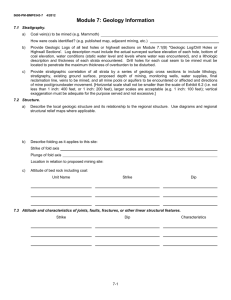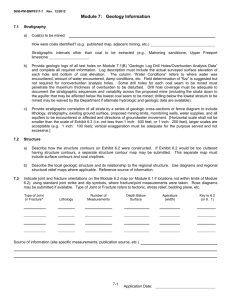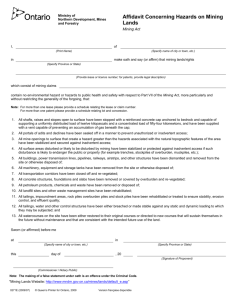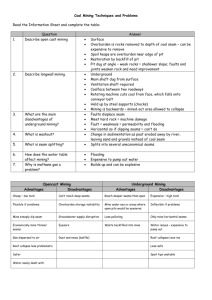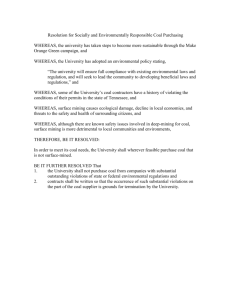08 Module 7 - Geologic Information (2)
advertisement
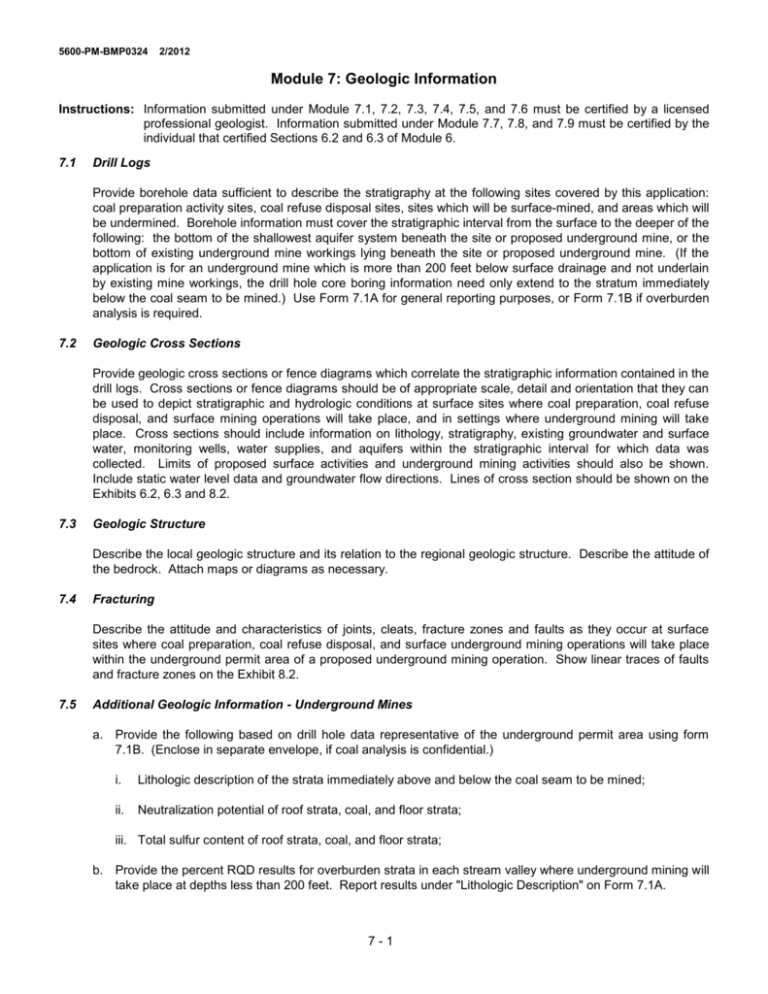
5600-PM-BMP0324 2/2012 Module 7: Geologic Information Instructions: Information submitted under Module 7.1, 7.2, 7.3, 7.4, 7.5, and 7.6 must be certified by a licensed professional geologist. Information submitted under Module 7.7, 7.8, and 7.9 must be certified by the individual that certified Sections 6.2 and 6.3 of Module 6. 7.1 Drill Logs Provide borehole data sufficient to describe the stratigraphy at the following sites covered by this application: coal preparation activity sites, coal refuse disposal sites, sites which will be surface-mined, and areas which will be undermined. Borehole information must cover the stratigraphic interval from the surface to the deeper of the following: the bottom of the shallowest aquifer system beneath the site or proposed underground mine, or the bottom of existing underground mine workings lying beneath the site or proposed underground mine. (If the application is for an underground mine which is more than 200 feet below surface drainage and not underlain by existing mine workings, the drill hole core boring information need only extend to the stratum immediately below the coal seam to be mined.) Use Form 7.1A for general reporting purposes, or Form 7.1B if overburden analysis is required. 7.2 Geologic Cross Sections Provide geologic cross sections or fence diagrams which correlate the stratigraphic information contained in the drill logs. Cross sections or fence diagrams should be of appropriate scale, detail and orientation that they can be used to depict stratigraphic and hydrologic conditions at surface sites where coal preparation, coal refuse disposal, and surface mining operations will take place, and in settings where underground mining will take place. Cross sections should include information on lithology, stratigraphy, existing groundwater and surface water, monitoring wells, water supplies, and aquifers within the stratigraphic interval for which data was collected. Limits of proposed surface activities and underground mining activities should also be shown. Include static water level data and groundwater flow directions. Lines of cross section should be shown on the Exhibits 6.2, 6.3 and 8.2. 7.3 Geologic Structure Describe the local geologic structure and its relation to the regional geologic structure. Describe the attitude of the bedrock. Attach maps or diagrams as necessary. 7.4 Fracturing Describe the attitude and characteristics of joints, cleats, fracture zones and faults as they occur at surface sites where coal preparation, coal refuse disposal, and surface underground mining operations will take place within the underground permit area of a proposed underground mining operation. Show linear traces of faults and fracture zones on the Exhibit 8.2. 7.5 Additional Geologic Information - Underground Mines a. Provide the following based on drill hole data representative of the underground permit area using form 7.1B. (Enclose in separate envelope, if coal analysis is confidential.) i. Lithologic description of the strata immediately above and below the coal seam to be mined; ii. Neutralization potential of roof strata, coal, and floor strata; iii. Total sulfur content of roof strata, coal, and floor strata; b. Provide the percent RQD results for overburden strata in each stream valley where underground mining will take place at depths less than 200 feet. Report results under "Lithologic Description" on Form 7.1A. 7-1 5600-PM-BMP0324 i. 7.6 2/2012 Additional RQD results may be required in circumstances where the applicant is proposing multiple seam mining, where an alternative pillar plan is submitted, or for areas where postmining mine pool levels may exceed surface elevations or where there is a potential flow loss in streams. Additional Geologic Information on Sites where Overburden will be Excavated Note: The requirement for overburden analysis may be applicable to any site where overburden is removed to the level of a mineable coal seam and should be resolved prior to application submittal. This can be done as part of the pre-application review process or more informally through a meeting and discussion with District Office personnel. a. Request for Waiver of Overburden Analysis Yes No Typically, the Department will not grant waivers if the proposed site meets any of the following criteria: i. Lies within a High Quality, Exceptional Value, Wilderness Trout Stream or other stream sensitive to mining impact; ii. Is in proximity to a public water supply; iii. There is an absence of mining in the watershed or little mining on seam(s) of interest; iv. There is an indication of acid or elevated metals from the same seam(s) on adjacent mines; or v. Removal of alkaline material is proposed. As stated above, if the proposed site clearly qualifies under one of the above five (5) categories, overburden analysis will almost certainly be required. If a waiver is requested, the applicant must provide a written narrative explanation and documentation supporting the basis for the waiver. This narrative must provide evidence that there is equivalent information available and must include: vi. A discussion as to the relationship between the proposed site and the five (5) categories discussed above; vii. An explanation as to the existing hydrogeologic information that supports the waiver (e.g. stratigraphy, water chemistry, nearby overburden analyses, and so forth); and viii. Previous mining history on the watershed or adjacent areas (including percentage or relative acreages of mined and unmined portions of the watershed) and the postmining water quality associated with the proposed seams (including specific examples). b. Overburden Analysis Report The overburden analysis report must include at a minimum: i. Geologic logs of overburden analysis test holes. This must include a lithologic description (including the information requested in Form 7.1B, lithologic thickness of strata and depth of strata, type of drill used, collar elevation and the geologist who logged the hole. The Munsell system is to be used for color identification. Water condition information must include static water level (measured 24 or more hours after drilling), where water was encountered and estimated yield. This information is to be presented on a completed Form 7.1B “Overburden Analysis Data“ or on a similar form approved by the Department. An explanation of considerations employed in determining the following: ii. (1) Borehole spacing and number of holes, (2) Sampling depth, and (3) Sampling intervals of overburden analysis test holes. A series of stratigraphic cross-sections or fence diagrams including all overburden analysis test holes, plus other representative test holes. It is suggested that the vertical exaggeration not be more than five (5) times the horizontal scale. The vertical scale must be sufficient to show all potentially acidic and alkaline zones and any zones proposed for special handling; a scale of one (1) inch to 20 feet or 7-2 5600-PM-BMP0324 2/2012 greater is recommended. The stratigraphic correlations between overburden holes and other test holes must be shown. Additionally hydrogeologic information (such as water table, perched systems and so forth) should be portrayed. iii. Overburden holes accurately located on Exhibit 6.2. Overburden holes must be surveyed such that surface elevations and hole locations are accurately determined and plotted. iv. Results of the chemical analysis of all overburden strata, coals and strata immediately below the coal. Acid-base accounting data must be presented on Form 7.1B “Overburden Analysis Data” or on a similar form approved by the Department Actual laboratory analysis sheets may be submitted in addition to Form 7.1B. Forms of sulfur (when submitted) should be submitted on a separate sheet. v. Techniques and methods of chemical analyses. References pertaining to technique or method should be cited as appropriate (e.g. Sobek, and others 1978, p. 47-50; ASTM Method D2492-84) and where a standard method is not used or has been modified, the method used should be described in detail. vi. An identification of any stratigraphic units possessing the potential for significant acid or alkaline production and an overall interpretation of the overburden analysis data. The criterion and rationale by which the overburden is being judged must be explained. vii. The name, address and telephone number of the individual(s) responsible for the collection and analysis of the data and interpretation of the data. 7.7 Surface Mines and Coal Refuse Disposal Areas Submit the following information on all active, completed and abandoned surface mines and coal refuse disposal sites which lie within 1,000 feet of the permit area. Show sites on Exhibits 6.2, 6.3 and 9.1. Operator: Site Name: Permit No.: Map Key: Status: Coal Seams: Augering: (yes/no) Discharge: (yes/no) 7.8 Underground Mines Submit the following information on all active, completed and abandoned underground mines, which lie within 1,000 feet of the permit area. Show boundaries and openings on Exhibits 6.2, 6.3, and 9.1. Operator: Site Name: Permit No.: Map Key: Status: Coal Seams: Opening Elev.’s: Discharge Elev.’s: Mine Pool Elev.’s: 7-3 5600-PM-BMP0324 7.9 2/2012 Waste Disposal Facilities/Sites Submit the following information on all hazardous, municipal, and residual waste disposal sites (either active or completed) which lie within 1,000 feet of the permit area. Show sites on Exhibits 6.2, 6.3, and 9.1. Operator: Site Name: Permit No.: Map Key: Status: Waste Type: 7-4 5600-PM-BMP0324 2/2012 FORM 7.1A GEOLOGIC CORE BORING LOG Page 1 of Hole No.: Surface Elevation: Bottom of Coal Elevations: Groundwater Elevations: and Date Measured Surveyed by: Remarks: Log Method: Depth Thickness Typical Rock Name Operation Name: Method of Drilling: Date Drilled: Drilled By: Logged By: Township: County: Quadrangle: Laboratory: UTM’s zone Latitude: Ground Water Condition 7-5 Northing ____ Easting: Longitude: Lithologic Description/RQD (if applicable) or 5600-PM-BMP0324 2/2012 FORM 7.1B OVERBURDEN ANALYSIS DATA Hole No.: Surface Elev. (surveyed): Bottom of Coal Elevations: Groundwater Elevations: and Date Measured Surveyed by: Remarks: ThickDepth ness Method: Scale Graphic Log Lithologic Description and Water Conditions Operation Name: Method of Drilling: Date Drilled: Drilled By: Logged By: Township: County: Quadrangle: Laboratory: UTM’s zone Latitude: Color or Munsell Code 7-6 OBA Sample No. Northing Easting: or Longitude: Log Interval % Total Sulfur Fizz Rating Neutralization Potential
